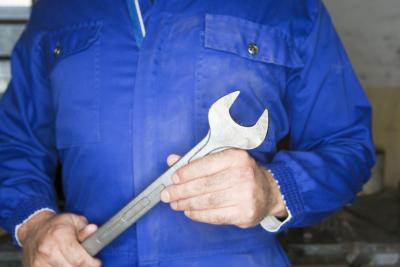
The clutch on your 1998 Toyota Tacoma presses against the the flywheel with the help of a pressure plate so that the engine and transmission are connected together. This, in turn, allows the power to be transferred from the transmission to the drive wheels. However, because the clutch is composed of friction materials, the clutch assembly will wear out over time. When this happens, you need to replace the clutch. But before you replace it, you can troubleshoot some issues that will verify a problem with the clutch on your Tacoma.
Open the hood of your Tacoma. Look for the clutch master cylinder mounted to the firewall. The clutch master cylinder will be a small metal cylindrical component with a translucent reservoir tank on top of the actual cylinder. The cap on top of the reservoir tank will say "clutch fluid". Check the clutch fluid level. The fluid level should be between the upper and lower marks on the side of the reservoir tank. If the fluid level is too low, fill the tank with DOT3 brake fluid until it is between the upper and lower marks. If the clutch fluid has gotten low enough to let air into the system, your Tacoma will have problems disengaging the clutch. When this happens, it is difficult to get the truck into gear from neutral, and the truck will have a tendency to roll when in gear, even when the clutch pedal is all the way in. Sometimes, but not always, there is air in the clutch line that needs to be bled out when you have chronic low clutch fluid levels. A professional mechanic can bleed the line for you. If your fluid is not low, but the truck displays these symptoms, it may mean that either the master or slave clutch cylinders are worn out, and passing fluid internally.
Check for clutch slippage. When you drive your Tacoma, the clutch should engage smoothly and stay engaged. If you're driving and the clutch slips, allowing the engine to rev while in gear, the clutch disc has worn sufficiently that you will need to have it replaced. Note that this will feel as though the transmission is slipping out of gear, but it is not. It is the clutch slipping against the flywheel. This will probably be more noticeable in high gear.
If you hear a rumbling or grinding noise when you push down on the clutch pedal, this indicates a worn throwout bearing. If your throwout bearing is sufficiently worn, you should have the entire clutch assembly replaced.